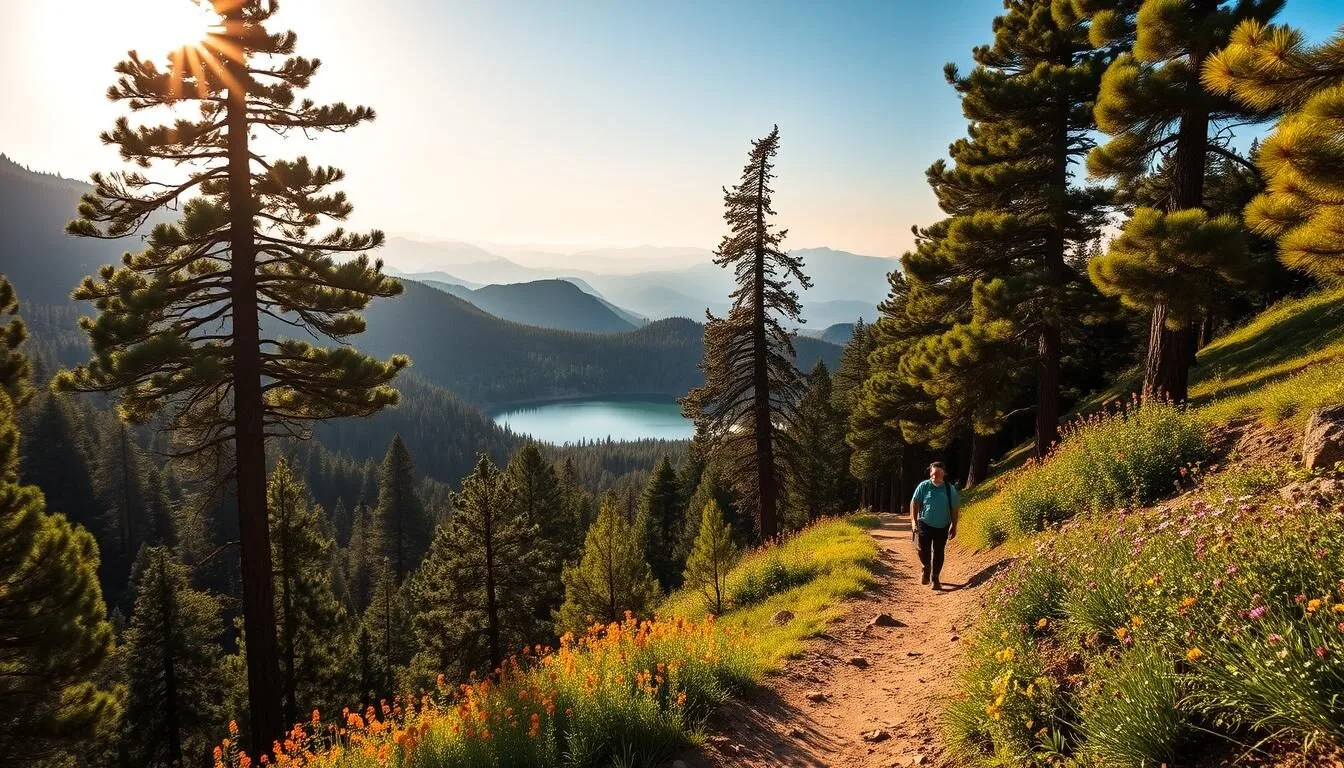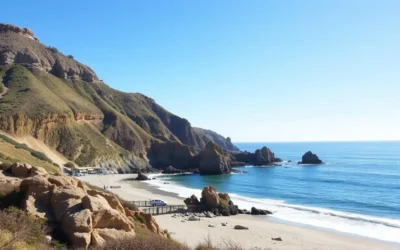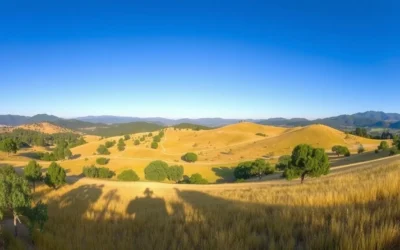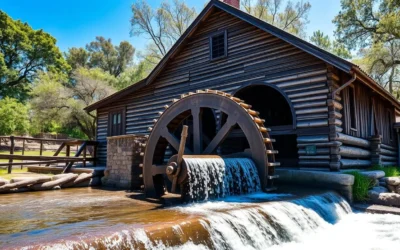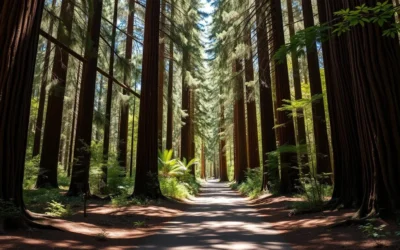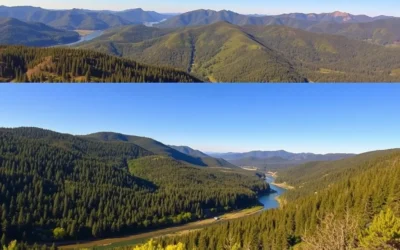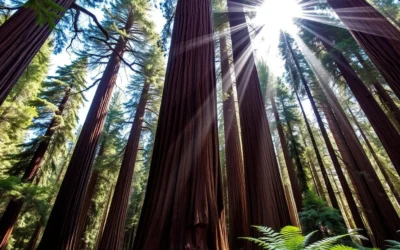✓ Accommodations✓ Flights✓ Rental Cars
Nestled in the San Gabriel Mountains, Mount Baldy offers a unique alpine experience unlike anywhere else in the Los Angeles area. With its elevation at 10,064 feet, the mountain creates a distinct environment that attracts hikers and nature lovers alike.
As you hike through the trails, you’ll encounter breathtaking water features, from seasonal snowmelt lakes to cascading waterfalls. The area’s natural beauty is a treasure trove of exciting experiences, making it an ideal destination for outdoor enthusiasts.
You can explore the various water attractions available throughout the year and enjoy the comprehensive guide to water-based activities and hiking trails. Whether you’re looking for a leisurely stroll or an adrenaline-packed adventure, Mount Baldy has something for everyone.
Discovering Mount Baldy’s Alpine Lakes
The alpine lakes of Mount Baldy offer a serene escape amidst the grandeur of Southern California’s highest peak. As you explore the area, you’ll uncover the unique characteristics of these lakes and their significance within the region.
Mount Baldy: Southern California’s Highest Peak
Mount Baldy, officially known as Mount San Antonio, stands at an impressive 10,064 feet, making it the highest peak in Los Angeles County. This elevation creates a diverse range of ecosystems, from the treeless summit areas to the lush canyons and valleys below. The mountain’s height and location within the San Gabriel Mountains National Monument and Angeles National Forest make it a popular destination for hikers and nature enthusiasts.
| Feature | Description |
|---|---|
| Elevation | 10,064 feet |
| Location | San Gabriel Mountains National Monument, Angeles National Forest |
| Popular Activities | Hiking, trail running, photography |
The San Gabriel Mountains Watershed
The San Gabriel Mountains watershed, which includes Mount Baldy, plays a crucial role in supplying water to surrounding communities. The seasonal snowmelt from Mount Baldy’s higher elevations feeds the lakes and water features within the watershed, creating a rich and diverse ecosystem. This watershed not only supports local wildlife but also offers recreational opportunities for visitors, making it a vital component of the region’s environmental and social fabric.
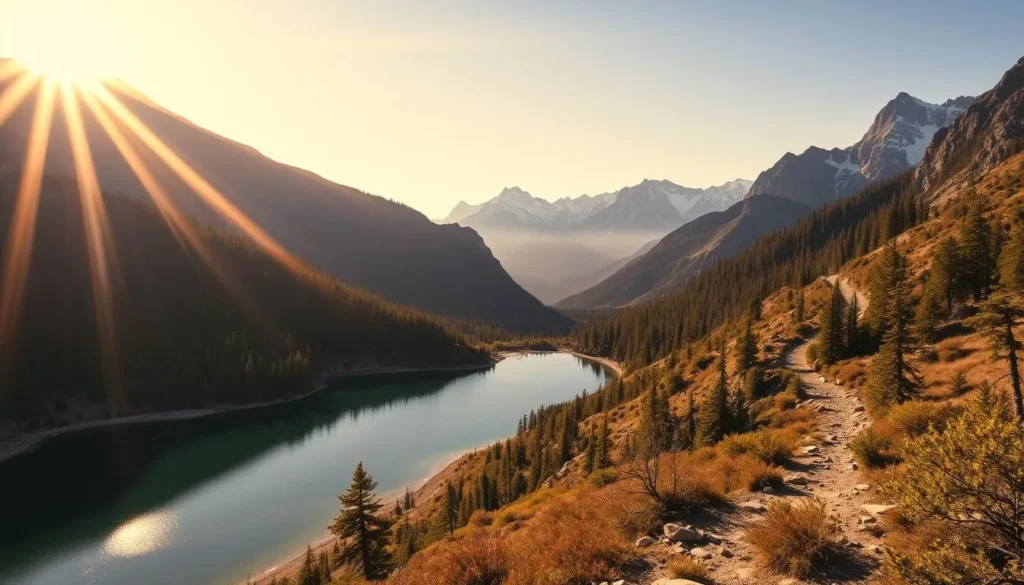
As you explore Mount Baldy’s alpine lakes, you’ll gain a deeper appreciation for the intricate balance between the mountain’s ecosystems and the watershed that sustains them.
San Antonio Falls: Mount Baldy’s Most Accessible Water Feature
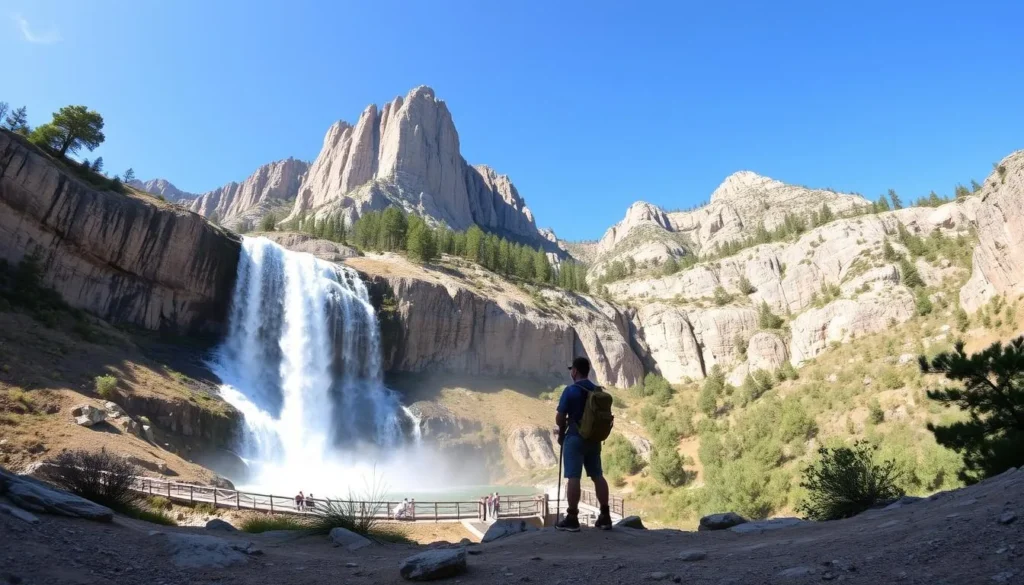
If you’re looking for a picturesque waterfall in Mount Baldy, San Antonio Falls is a must-visit. This beautiful waterfall is accessible via a short hike on the Baldy Bowl Ski Hut Trail.
Trail to San Antonio Falls
The trail to San Antonio Falls is approximately a half-mile hike from the first switchback on the Baldy Bowl Ski Hut Trail. As you make your way up the trail, you’ll catch a glimpse of the falls to your left, about a mile up the mountain.
Best Times to Visit the Falls
The flow of San Antonio Falls varies dramatically with the seasons. In the spring, the waterfall is at its peak, with melting snow creating a powerful cascade. During the summer months, the flow lessens, and by late summer, it can be a mere trickle, especially during drought periods. The best time to visit is in the spring when the water flow is at its maximum.
When visiting San Antonio Falls, be sure to take in the surrounding beauty and capture the moment with your camera. The falls make for a great photography subject, with the mountain landscape providing a stunning backdrop.
Exploring Baldy Bowl and Its Seasonal Lake
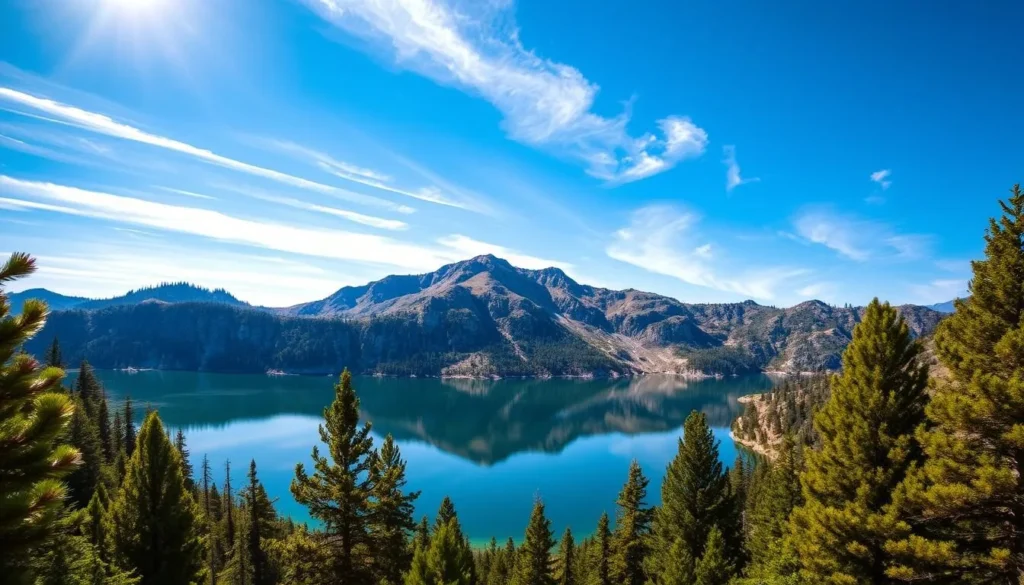
Nestled in the heart of Mount Baldy, the Baldy Bowl is a seasonal wonder that captivates visitors with its ephemeral beauty. As you hike through this area, you’ll witness a dramatic transformation from a snow-covered ski destination in winter to a basin containing a small alpine lake during spring snowmelt.
The Sierra Club Ski Hut Area
As you continue on the trail, you’ll soon cross a seasonal stream right before reaching the Sierra Club Ski Hut. This hut is available for rent and can accommodate up to 16 people. Be sure to check the opening hours and contact the scheduled host in advance if you plan to stay here. The hut offers a pit toilet and a place to refill your water bottle.
Spring Snowmelt Waters
The spring snowmelt creates temporary water features throughout the Baldy Bowl area, providing unique photography opportunities. These seasonal water sources are crucial for local wildlife and plant communities in this otherwise dry mountain environment. As you hike through the area, be mindful of the changing conditions and enjoy the fleeting beauty of the snowmelt.
To make the most of your visit, be sure to trail safely and consider the seasonal conditions. The Baldy Bowl area is a true gem of Mount Baldy, offering an unforgettable experience for those who venture here.
Lakes of Mount Baldy, California: Best Things to Do – Top Picks
Mount Baldy’s alpine lakes provide the perfect setting for a day of hiking, photography, and picnicking. The area offers a variety of things to do, catering to different interests and preferences.
Hiking and Trail Running
For hiking enthusiasts, Mount Baldy has numerous trails that offer breathtaking views of the surrounding landscape. The hike to the lakes is a popular choice, with trail running being another exciting option for those looking for an adventure.
- Explore the various trails, each with its unique charm and challenge.
- Enjoy the scenic views and potentially spot local wildlife.
Photography and Wildlife Watching
The lakes and surrounding areas are a photographer’s paradise, offering stunning alpine scenery. Visitors can capture the beauty of the lakes and potentially spot local wildlife, making it ideal for photography and wildlife watching.
- Capture the serene beauty of the lakes and surrounding mountains.
- Keep an eye out for local wildlife, including birds and other animals.
Picnicking and Relaxation
For those looking to relax, there are perfect picnic spots near the lakes and streams. Visitors can enjoy a meal surrounded by natural beauty, making for a peaceful and rejuvenating experience.
- Find a serene spot to enjoy a meal and relax.
- Take in the natural beauty of the surroundings and unwind.
By incorporating these activities into your visit, you can maximize your day at Mount Baldy’s lakes and enjoy a memorable adventure.
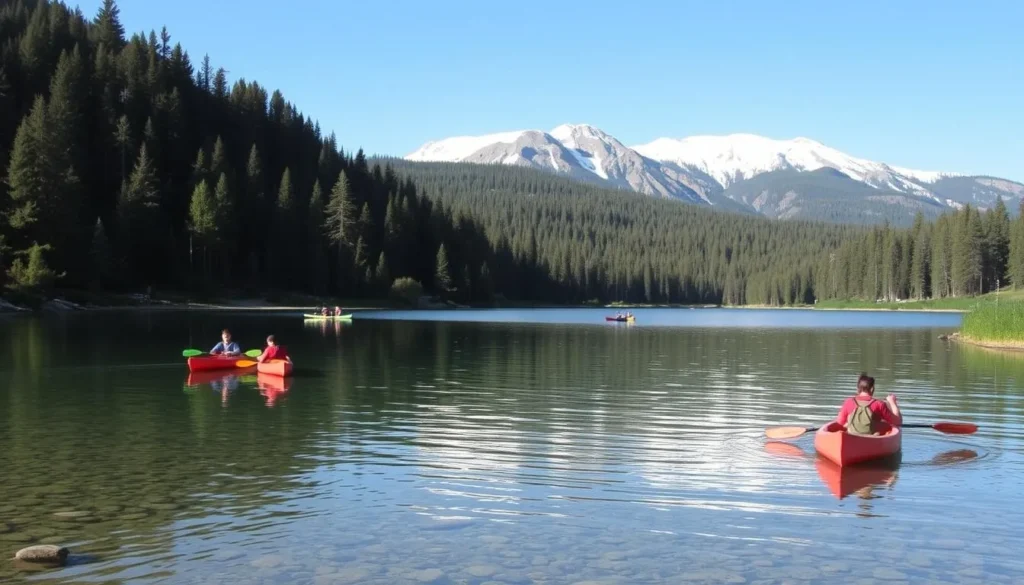
Seasonal Water Activities at Mount Baldy
Mount Baldy’s water features offer a range of activities that change with the seasons. As the weather warms up, the lakes and streams become accessible for various summer activities.
Summer Water Adventures
During the summer months from June to October, the trails are typically clear, and water features are accessible without specialized equipment. You can enjoy hiking and exploring the beautiful lakes and streams. To avoid crowds, consider starting your hike early in the morning, and try to visit during the weekdays.
- Explore the lakes and streams by hiking or trail running.
- Enjoy picnicking and relaxation in the scenic surroundings.
- Take in the breathtaking views and capture memorable photos.
Winter Snow and Ice Activities
In the winter, Mount Baldy’s lakes and streams transform into snow and ice formations, creating opportunities for experienced adventure seekers. If you’re skilled in mountaineering, you can enjoy snow sports and explore the winter landscape. However, be aware of the dangers of winter conditions and take necessary safety precautions.

By understanding the seasonal changes and taking necessary precautions, you can enjoy Mount Baldy’s water features throughout the year.
Best Hiking Trails to Mount Baldy’s Water Features
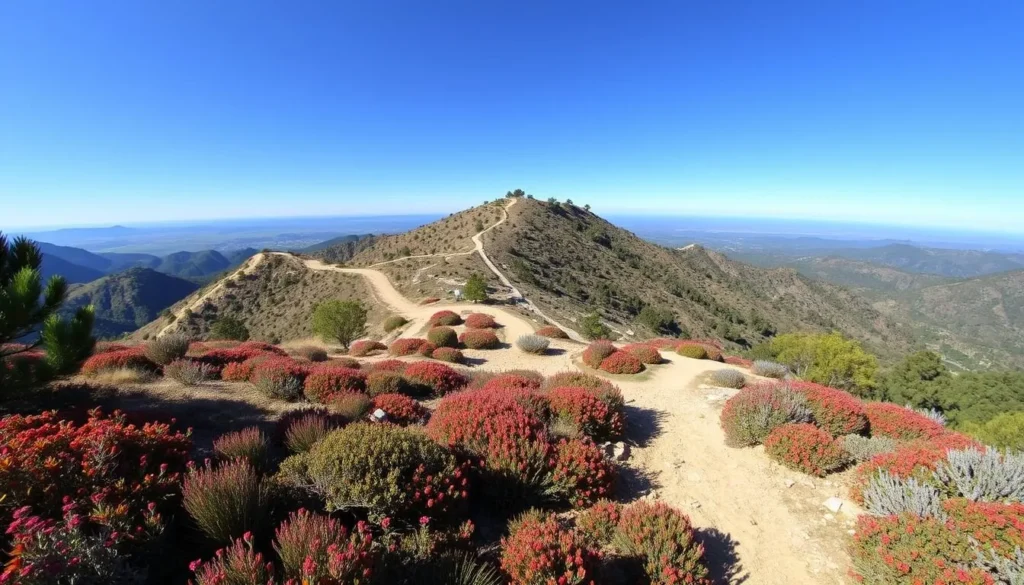
Mount Baldy offers several hiking trails that lead to its breathtaking water features, each with its unique charm and challenge. Whether you’re a seasoned hiker or just starting out, the trails around Mount Baldy provide a range of experiences that cater to different skill levels and preferences.
Devil’s Backbone Trail
The Devil’s Backbone Trail is a picturesque route known for its dramatic ridgeline views. However, it requires caution, especially when the trail is wet and icy, due to its steep dropoffs. This trail is ideal for those who enjoy scenic views and are comfortable with challenging terrain.
Baldy Bowl Trail
The Baldy Bowl Trail, also known as the Ski Hut Trail, provides access to seasonal streams and the Sierra Club Ski Hut area. This trail is a favorite among beginners who start with the Devil’s Backbone Trail and then descend via Baldy Bowl for a more enjoyable experience.
Bear Canyon Trail
For those seeking a more challenging and less crowded hike, the Bear Canyon Trail offers solitude and access to hidden water features. This trail is not for the faint of heart, as it presents a tougher hiking experience compared to the more popular trails.
Each of these trails offers a unique perspective on Mount Baldy’s natural beauty, from the dramatic views of the Devil’s Backbone Trail to the serene landscapes accessible via the Baldy Bowl and Bear Canyon Trails. By choosing the right trail based on your experience level and preferences, you can enjoy a fulfilling hiking experience in this beautiful region.
Safety Tips for Visiting Mount Baldy Lakes
Visiting Mount Baldy’s lakes can be a breathtaking experience, but it’s crucial to be aware of the potential hazards. Every year, unprepared hikers face serious risks, and some even lose their lives due to the challenging weather conditions and treacherous terrain.
Weather Considerations and Hazards
Mount Baldy is known for its unpredictable weather, with sudden storms and high winds that can make hiking trails dangerous. In the winter, the trails can become icy and slippery, increasing the risk of falls. It’s essential to check the weather forecast before heading out and to be prepared for changing conditions.
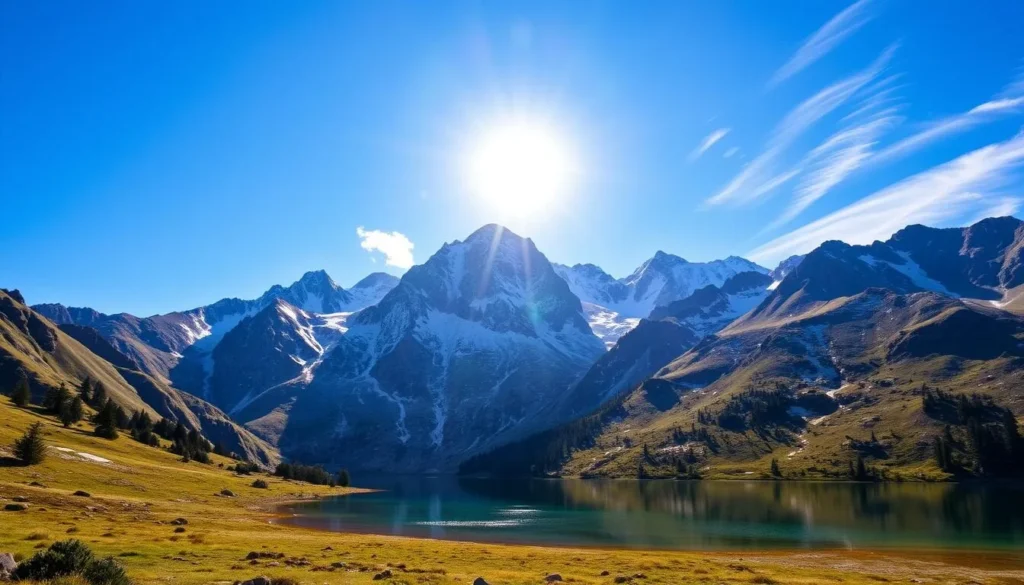
Essential Safety Gear
To ensure a safe visit to Mount Baldy’s lakes, it’s vital to pack the right safety gear. This includes proper footwear with good traction, layers for changing weather conditions, navigation tools, and sufficient water. Additionally, being aware of the trail conditions and potential hazards such as snow and ice can help you prepare for the hike.
By understanding the potential risks and taking necessary precautions, you can enjoy a safe and memorable visit to Mount Baldy’s beautiful lakes.
Planning Your Visit: When to Go and What to Bring
To make the most of your visit to Mount Baldy’s alpine lakes, it’s essential to know when to go and what to bring. The experience can vary greatly depending on the time of year and your preparation.
Best Months to Visit Mount Baldy Lakes
The best time to visit Mount Baldy’s lakes is from late spring through early fall, typically May to October. During these summer months, the weather conditions are generally favorable for hiking and outdoor activities. However, it’s crucial to check the weather forecast specifically for Mount Baldy’s higher elevations, as conditions can differ significantly from those in nearby Los Angeles. Understanding the optimal time to visit helps you avoid unfavorable conditions and make the most of your trip.
Visiting during the weekdays and early in the morning can help you avoid crowds at popular water features, making for a more serene experience.
Packing Essentials for Lake Activities
When preparing for your visit, it’s vital to pack the right gear. Bringing at least 3L of water is recommended to stay hydrated, especially considering the high altitude of 10,064 feet, which can cause dehydration. Additionally, pack layers for changing temperatures, sun protection, and appropriate footwear for your planned activities. Being prepared will enhance your experience and ensure your safety during the hike.
![]()
It’s also worth noting that some visitors may experience altitude sickness, particularly those coming from sea level. Being aware of this and taking necessary precautions can make a significant difference in your visit.
Accommodation Options Near Mount Baldy Lakes
For those looking to explore Mount Baldy’s lakes, several accommodation options are available in the area. Whether you’re looking for a camping experience or more comfortable lodging, Mount Baldy has something to offer.
Manker Flats Campground
Manker Flats Campground is a great choice for campers, with 21 first-come, first-served sites available. The campground is conveniently located near the trailhead, making it an ideal starting point for your hikes. Each site comes with picnic tables and fire rings, and there are flushable toilets on site. The cost is $10 per night with an Adventure Pass, or $14 per night otherwise.
Sierra Club Ski Hut
For a unique experience, consider staying at the Sierra Club Ski Hut, which can accommodate up to 16 people. This hut is perfect for ski enthusiasts and requires advance reservation with the scheduled host. It’s a great way to immerse yourself in the mountain environment.
Mount Baldy Lodge and Cabins
If you prefer more comfortable accommodations, Mount Baldy Lodge and Cabins are a great option. After a day of hiking or exploring, you can relax in the comfort of your cabin. The lodge offers a more luxurious stay, making your adventure even more enjoyable.
Additionally, there are 12 tent cabins available at the Mount Baldy lift area, within walking distance from the Top of the Notch Restaurant. Tent cabin rental includes round-trip lift tickets, as well as arrival night dinner and breakfast, making for a convenient and enjoyable stay.
Transportation and Parking Information
When planning your trip to Mount Baldy’s lakes, it’s essential to consider your transportation options and parking arrangements. The Mt Baldy trailhead is located just past the Manker Campground, approximately 1:15 hours east of downtown Los Angeles. You’ll drive through Mt Baldy Village on your way to the hike.
Getting to Mount Baldy from Los Angeles
The drive from Los Angeles to Mount Baldy is a scenic one, taking around 1:15 hours from downtown LA. You’ll pass through Mt Baldy Village, where you can stop for supplies or information before heading to the trailhead. Make sure to check the current road conditions before you leave, as the roads can be affected by weather, especially during winter months.
Parking Passes and Regulations
According to the USDA, you no longer need a parking pass to park at the Manker Flats Trailhead lot. However, if you have a parks pass or Adventure Pass, it’s recommended to display it to avoid any potential issues. If you plan to park at the Manker Campground, which is below the trailhead, you will need to have a valid pass. Be aware that there have been reports of thefts at the trailhead parking lot, so it’s advisable not to leave valuables visible in your car.
- Arrive early, especially on weekends, to secure parking as the lot fills quickly.
- Consider alternative parking options, such as the Mount Baldy Ski Lift area, which may require additional fees.
- Keep valuables out of sight to prevent theft.
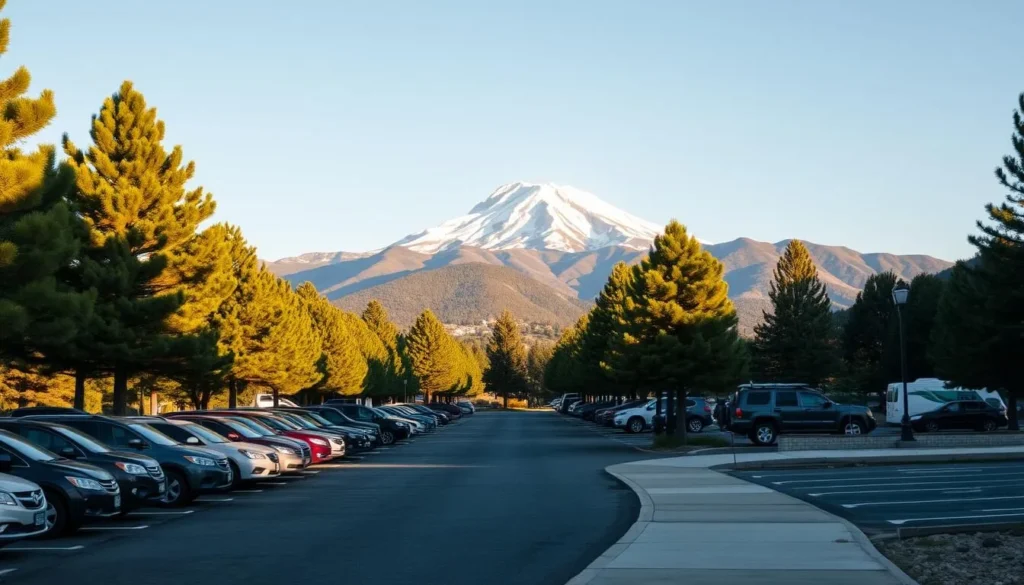
Nearby Lakes Worth Visiting
The San Bernardino Mountains are dotted with picturesque lakes, including Big Bear Lake and Lake Arrowhead, near Mount Baldy. These lakes offer a range of activities and scenic beauty, making them great additions to your mountain adventure.
Big Bear Lake
Big Bear Lake, about an hour’s drive from Mount Baldy, offers year-round recreational activities, including swimming, fishing, boating, and winter sports. It’s an ideal spot for a day trip or a longer stay, providing various amenities and services.
Lake Arrowhead
Lake Arrowhead, known as the “Alps of Southern California,” boasts pristine waters and an upscale village atmosphere. You can enjoy water activities, hiking, and exploring the charming village with its shops and eateries.
Both Big Bear Lake and Lake Arrowhead serve as excellent alternatives when Mount Baldy’s conditions aren’t ideal for hiking. They offer a different yet equally captivating mountain experience, making them perfect for extending your getaway in the San Bernardino Mountains.
Conclusion: Making the Most of Mount Baldy’s Alpine Waters
Mount Baldy’s alpine lakes and streams offer a unique and unforgettable experience in Southern California. As you hike through the San Gabriel Mountains, you’ll discover the beauty of seasonal lakes, majestic waterfalls, and serene streams.
To make the most of your visit, it’s essential to plan ahead and consider the weather conditions. Checking the forecast and being prepared for changing conditions will ensure a safe and enjoyable hike to the summit or a leisurely walk along the trail.
The best time to visit depends on your preferences: spring brings flowing waters, while summer offers more accessible hiking conditions. Whether you’re looking for a challenging hike or a relaxing picnic by a stream, Mount Baldy’s water features have something for everyone.
As you enjoy the natural beauty of Mount Baldy, remember to preserve its fragile alpine ecosystems for future generations. With proper planning and a respect for nature, you can have a memorable and enjoyable experience in this special destination.
The above is subject to change.
Check back often to TRAVEL.COM for the latest travel tips and deals.
